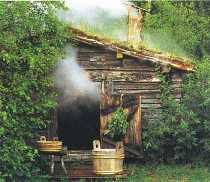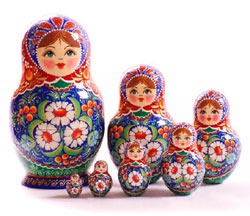Symbols of Russia.
Samovar
The Samovar – the Russian tea machine, as it was referred to in Western Europe – stands out against all other water-heating devices.
The literal meaning of "samo-var” is "self-boiling”. In earlier times the samovar was used not only for boiling water, but also for boiling soup and sbiten (hot honey&spice drink).
Throughout all the history of the samovar its design and decoration changed according to fluctuations of taste and fashion. Initially the samovars showed an impact of rococo style, then inclination to empire style, and in the end of their existence did not avoid the influence of art nouveau.


Russian Bear
The Bear — a significant factor of Russian culture - appears in many Russian literary works, folk tales, epics, proverbs and sayings, not infrequently acting as a protagonist. The Bear was the emblem of the XXII Olympic Games held in Moscow in 1980.
The Bear — a significant factor of Russian culture - appears in many Russian literary works, folk tales, epics, proverbs and sayings, not infrequently acting as a protagonist. The Bear was the emblem of the XXII Olympic Games held in Moscow in 1980.
In Russian culture the bear traditionally appears as the image of a good-natured and a somewhat dumb animal, undoubtedly possessing certain charisma. In folklore the Bear is usually named affectionately and respectfully as a man: Mishka, Mihailo Potapych, Toptygin, etc. So it is evident that the Bear is more likely a kind neigbour, or a guard, never a tyrant. Emblems of Russian cities say about the same thing.
Initially the bear as the symbol of Russian state appeared in Europe as personification of slowness, laziness, barbarity and aggression, which evokes in Europeans the feeling of their own superiority to the non-civilized "neighbour" and also the feeling of fear and, consequently, the desire to chain it. Certainly, Russia repeatedly gave its neighbours some grounds for fear, however, if Russian bear did not exist, one should have made it up.


Russian Stove



The stove was man’s unfailing helpmate in the olden days. The so-called "Russian stove” is a brick masonry heater, which is perhaps the most efficient and environment-friendly of all wood burning fireplaces ever invented by man. Throughout many centuries Russian stoves were used both for cooking meals, baking bread and pies, drying grains, mushrooms, and roots and for heating and drying the house in winter and autumn.
The Russian stove was not only a heater and a cooker, but also a doctor, healing the family folks from any colds. Moreover, it provided a perfect sleeping nook: the plank bed, arranged between the stove and a wall, just beneath the ceiling, gained plenty of warm air (which always ascends, following the law of physics).
Many good guys of Russian wonder tales are fond of sitting or lying on the stove. Thus, the epic strongman Ilya Muromets spends 33 years of his life lying on the stove before he takes to various feats, whereas another tale hero, Yemelia, unwilling to leave his warm stove bench, drives the stove as if it were a comfy car. Same love of the stove is inherent in Baba Yaga, the evil witch who uses it in her attempts to fry the kidnapped children or lost heroes.
Father Frost the Red Nose
The key figure of the Russian New Year is certainly Ded Moroz (Father Frost, or Grandfather Frost, to be more exact) who arrives wearing a red caftan (old-style long garment) decorated with traditional embroidering and edged with snow-white fluff, a red cap, white mittens and felt boots. Boasting a luxuriant snow-white beard, ruddy nose and cheeks, and a cordial smile, he is leaning on an icy staff with a sparkling star on its top and carrying a huge red sack with presents for kids.
Ded Moroz is usually accompanied by his fairy granddaughter Snegurochka (Snow Maiden), who helps him play with kids and present the gifts. She is a unique attribute of the image of Father Frost – none of his foreign colleagues has such a cute companion. The image of Snegurochka personifies frozen waters. She is an enigmatic maid (not a small girl) wearing purely white garments. No other colour is allowed by traditional symbolism. On her head she is wearing an eight-radial crown decorated with silver and pearls.


Banya, the Russian Rite of Steam Bath
Banya is one of the most ancient traditions of the Russian people. Russian steam bath is a full-fledged philosophy, as well as invigorative pleasure compared to nothing and true relief for one’s soul. Traditionally, Russian steam bath is a log hut with three rooms, namely entrance room (called predbannik), washing room and steam room (parilka). The peculiarity of the true Russian steam bath is comparatively not high temperature, from 45 to 60 degrees centigrade and high relative humidity, 90 to 100 percent, which, according to the modern studies, provides better vaporization and more penetrating heating.
Apart from its practical purposes, banya played a great role in various rites. For example, it was considered necessary to go to banya before a wedding ceremony and the day after it, the visit being accompanied with a special ceremony.


What is Venik?
 From the days of hoary antiquity the Slavs whipped themselves and their fellows in banya with bunches of dried branches of birch, oak, maple, or other plplants. Strangely enough, the barbarian custom remains popular till date, probably because nothing can be compared to its reviving effect. Flogging with venik (a bunch of leafy branches) is a peculiar massage, increasing blood circulation, sweating and metabolism and cleansing the whole organism. The ether oils in venik leaves improve the condition of skin and produce anti-ageing effect, the fact known from ancient times. As the folks used to say: "You do not grow old on that day, when you steam in banya”.
From the days of hoary antiquity the Slavs whipped themselves and their fellows in banya with bunches of dried branches of birch, oak, maple, or other plplants. Strangely enough, the barbarian custom remains popular till date, probably because nothing can be compared to its reviving effect. Flogging with venik (a bunch of leafy branches) is a peculiar massage, increasing blood circulation, sweating and metabolism and cleansing the whole organism. The ether oils in venik leaves improve the condition of skin and produce anti-ageing effect, the fact known from ancient times. As the folks used to say: "You do not grow old on that day, when you steam in banya”.Nesting Doll Named Matryoshka
The nesting dolls, known as "matryoshki” have long conquered hearts of lovers of folk toys and original souvenirs all over the world. Matryoshka brings together the art of masters and enormous love of the Russian national culture.
The first matryoshka, that customary round-faced and plump girl wearing a kerchief and a Russian folk dress came into the world not at all in the days of hoary antiquity. The creation of this doll was prompted by the figurine of the Buddhist sage named Fukuruma that was brought to Abramtsevo Estate in the late 19th century from Honshu Island, Japan. As a story says a Russian monk once living in the Japanese island first started to cut such figurines. Inspired by the charming doll of the wooden sage with an oblong bald head and a good-humoured face, the toy turner Vasili Zvyozdochkin turned the first Russian matryoshka.
A gouache painted ruddy-faced wooden beauty girl with a rooster in her hands came out of the workshop Children’s Upbringing founded by the patron of arts Savva Mamontov. The first matryoshka was painted by the artists Sergei Malyutin. It was eight-seater, i.e. consisted of eight nesting dolls: inside of the big girl there was a smaller boy, and so on, the boys and girls alternating till the smallest, "indivisible” part, a swaddled baby. Where does the name Matryoshka come from?
What is the origin of this strange name? Some historians claim that the word comes from the popular Russian name Masha, or Manya, others relate it to the name Matryona (from the Latin "mater” denoting "mother”), or to the Hindu mother goddess Matri. Another version suggests the name means "mat’ tryoshki”, that is "mother of the three” (as translated from Russian), since initially one big Japanese doll nested three similar small dolls.



Cheburashka
Also known as Topple in earlier English translations, is a character in children's literature, from a 1966 story by the Russian writer Eduard Uspensky. He is also the protagonist of the stop-motion animated films by Roman Kachanov (Soyuzmultfilm studio), the first film of which was made in 1969.
According to the story, Cheburashka is a funny little creature, unknown to science, who lives in the tropical forest. He accidentally gets into a crate of oranges, eats his fill, and falls asleep. The crate is eventually delivered to a grocery store in an unnamed town where the rest of the main story unfolds. Cheburashka is a name given to the character by the puzzled store manager who finds the creature in the crate when he opens it. The salesman takes the animal out and sits him on the table, but his paws are numb after the long time spent in the crate, and he tumbles down ("cheburakhnulsya" (чебурахнулся), a Russian colloquialism, "tumbled" in English) from the table onto the chair and then from the chair, where he could not sit, for the same reason, onto the floor. The store manager, who witnesses the scene, called him Cheburashka.
Cheburashka has also been chosen as the official mascot for the Russian Olympic Team in the following games:
2004 Summer Olympics in Greece
2006 Winter Olympics in Turin, Italy (with white fur)
2008 Summer Olympics in Beijing, China (with red fur)
2010 Winter Olympics in Vancouver, Canada (with blue fur)
















